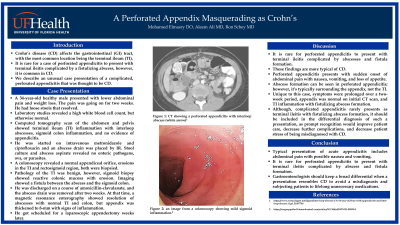Monday Poster Session
Category: Colon
P1715 - A Perforated Appendix Masquerading as Crohn’s
Monday, October 23, 2023
10:30 AM - 4:15 PM PT
Location: Exhibit Hall

Has Audio
- ME
Mohamed Elmasry, DO
University of Florida College of Medicine Jacksonville
Jacksonville, Florida
Presenting Author(s)
Mohamed Elmasry, DO1, Aleem A. Ali, MD1, Maged P. Ghali, MD2
1University of Florida College of Medicine Jacksonville, Jacksonville, FL; 2University of Florida, Jacksonville, FL
Introduction: Crohn’s disease (CD) affects the gastrointestinal (GI) tract, with the most common location being the terminal ileum (TI). It is rare for a case of perforated appendicitis to present with terminal ileitis complicated by a fistulizing abscess, however, it is common in CD. We describe an unusual case presentation of a complicated, perforated appendicitis that was thought to be CD.
Case Description/Methods: A 34-year-old healthy male presented with lower abdominal pain and weight loss. The pain was going on for two weeks. He had loose stools that resolved. Laboratory studies revealed a high white blood cell count, but otherwise normal. Computed tomography scan of abdomen and pelvis showed TI inflammation with inter-loop abscesses, sigmoid colon inflammation, and no evidence of appendicitis. He was started on intravenous metronidazole and ciprofloxacin and an abscess drain was placed. Stool culture and abscess aspirate revealed no enteric pathogens, ova, or parasites. A colonoscopy revealed a normal appendiceal orifice, erosions in the TI and rectosigmoid region, both were biopsied. Pathology of TI was benign, however, sigmoid biopsy showed reactive colonic mucosa with erosion. Imaging showed a fistula between the abscess and the sigmoid colon. He was discharged on a course of amoxicillin-clavulanate, and the abscess drain was removed after two weeks. At that time, a magnetic resonance enterography showed resolution of abscesses with normal TI and colon, but appendix was thickened to 8-mm with signs of inflammation. He got scheduled for a laparoscopic appendectomy weeks later.
Discussion: It is rare for perforated appendicitis to present with terminal ileitis complicated by abscesses and fistula formation. These findings are more typical of CD. Perforated appendicitis presents with sudden onset of abdominal pain with nausea, vomiting, and loss of appetite. Abscess formation can be seen in perforated appendicitis; however, it’s typically surrounding the appendix, not the TI. Unique to this case, symptoms were prolonged over a two-week period, appendix was normal on initial CT scan, and TI inflammation with fistulizing abscess formation. Although, complicated appendicitis rarely presents as terminal ileitis with fistulizing abscess formation, it should be included in the differential diagnosis of such a presentation, as prompt recognition would improve patient care, decrease further complications, and decrease patient stress of being misdiagnosed with CD.
Disclosures:
Mohamed Elmasry, DO1, Aleem A. Ali, MD1, Maged P. Ghali, MD2. P1715 - A Perforated Appendix Masquerading as Crohn’s, ACG 2023 Annual Scientific Meeting Abstracts. Vancouver, BC, Canada: American College of Gastroenterology.
1University of Florida College of Medicine Jacksonville, Jacksonville, FL; 2University of Florida, Jacksonville, FL
Introduction: Crohn’s disease (CD) affects the gastrointestinal (GI) tract, with the most common location being the terminal ileum (TI). It is rare for a case of perforated appendicitis to present with terminal ileitis complicated by a fistulizing abscess, however, it is common in CD. We describe an unusual case presentation of a complicated, perforated appendicitis that was thought to be CD.
Case Description/Methods: A 34-year-old healthy male presented with lower abdominal pain and weight loss. The pain was going on for two weeks. He had loose stools that resolved. Laboratory studies revealed a high white blood cell count, but otherwise normal. Computed tomography scan of abdomen and pelvis showed TI inflammation with inter-loop abscesses, sigmoid colon inflammation, and no evidence of appendicitis. He was started on intravenous metronidazole and ciprofloxacin and an abscess drain was placed. Stool culture and abscess aspirate revealed no enteric pathogens, ova, or parasites. A colonoscopy revealed a normal appendiceal orifice, erosions in the TI and rectosigmoid region, both were biopsied. Pathology of TI was benign, however, sigmoid biopsy showed reactive colonic mucosa with erosion. Imaging showed a fistula between the abscess and the sigmoid colon. He was discharged on a course of amoxicillin-clavulanate, and the abscess drain was removed after two weeks. At that time, a magnetic resonance enterography showed resolution of abscesses with normal TI and colon, but appendix was thickened to 8-mm with signs of inflammation. He got scheduled for a laparoscopic appendectomy weeks later.
Discussion: It is rare for perforated appendicitis to present with terminal ileitis complicated by abscesses and fistula formation. These findings are more typical of CD. Perforated appendicitis presents with sudden onset of abdominal pain with nausea, vomiting, and loss of appetite. Abscess formation can be seen in perforated appendicitis; however, it’s typically surrounding the appendix, not the TI. Unique to this case, symptoms were prolonged over a two-week period, appendix was normal on initial CT scan, and TI inflammation with fistulizing abscess formation. Although, complicated appendicitis rarely presents as terminal ileitis with fistulizing abscess formation, it should be included in the differential diagnosis of such a presentation, as prompt recognition would improve patient care, decrease further complications, and decrease patient stress of being misdiagnosed with CD.
Disclosures:
Mohamed Elmasry indicated no relevant financial relationships.
Aleem Ali indicated no relevant financial relationships.
Maged Ghali indicated no relevant financial relationships.
Mohamed Elmasry, DO1, Aleem A. Ali, MD1, Maged P. Ghali, MD2. P1715 - A Perforated Appendix Masquerading as Crohn’s, ACG 2023 Annual Scientific Meeting Abstracts. Vancouver, BC, Canada: American College of Gastroenterology.
